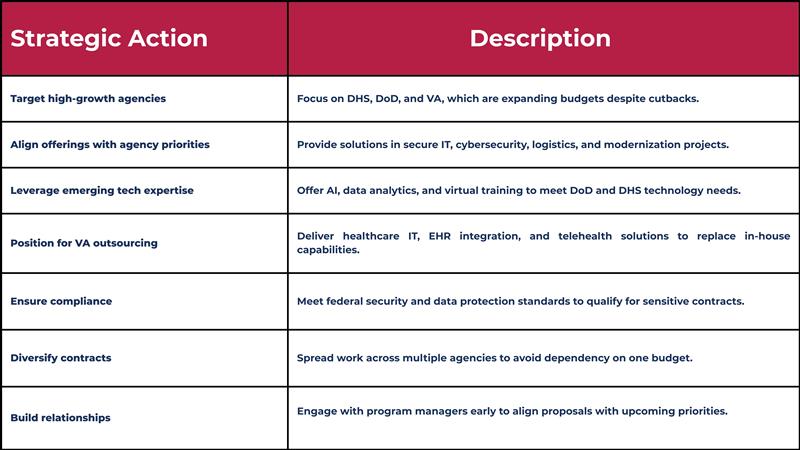2026 Budget Shifts: Reshape Your Federal Pipeline Now

Introduction
The FY 2026 federal budget is more than just numbers on a spreadsheet; it’s a roadmap that determines where opportunities will grow and where they’ll shrink for government contractors. Effective from October 1, 2025, this budget outlines how roughly $1.6 trillion in discretionary funding will be allocated. That figure reflects broad priorities balancing investments in defense, health, infrastructure, and technology modernization against fiscal constraints.so contractors must interpret these allocations to stay ahead of the curve. For contractors, one message is clear: adapt or risk losing your pipeline. With the right strategy, however, you can turn budget changes into growth opportunities and position yourself ahead of slower-moving competitors.
Understanding FY 2026 Budget Shifts
Every year, Congress and the White House work together to decide how federal funds are allocated. These decisions aren’t random; they reflect broader priorities, political realities, and urgent needs. For FY 2026, the themes are efficiency and accountability (doing more with less), security and modernization (cybersecurity and IT upgrades), and mission-critical priorities (funding core programs over administrative overhead). Contractors should note that agencies finalize spending plans by late summer: from July through September, agencies set goals and acquisition strategies for the new fiscal year. Waiting until Q1 to plan for FY 2026 means you’re already behind. Early alignment with agency goals is crucial to winning contracts under the new budget.
2026 Budget Shifts – Where Opportunities Are Growing
While some doors are closing, others are opening wider than ever. Three high-growth agencies stand out:
-
DHS – Department of Homeland Security: The DHS budget is skyrocketing. The FY 2026 proposal calls for about $107.4 billion in DHS funding – a 64.9% jump over FY 2025. Much of this is driven by homeland security priorities: completing the border wall, procuring advanced surveillance and cybersecurity technology, modernizing the Coast Guard’s fleet and facilities, and expanding Secret Service operations. With rising threats and natural disasters, DHS also needs skilled program managers and logistics experts. Contractors who offer secure IT systems, supply chain support, or disaster response solutions will find steady, long-term opportunities here.
-
DoD – Department of Defense: The DoD’s FY 2026 budget is roughly $1.01 trillion in total funding, a 13% increase from FY 2025. Of this, about $848.3 billion is discretionary and $113.3 billion is mandatory (totaling $961.6 billion for DoD). The focus is squarely on modernization: upgrading weapons systems, communications, and cybersecurity; and investing heavily in emerging tech like artificial intelligence, advanced data analytics, drones, autonomous systems, and simulation-based training. For example, DoD’s first-ever dedicated budget line for autonomy and AI is $13.4 billioni, and another $15.1 billion is earmarked for cybersecurity. With global security challenges mounting, the DoD’s appetite for cutting-edge solutions is only increasing. Contractors with expertise in secure IT infrastructure, AI-driven tools, logistics modernization, or advanced training (e.g. VR simulations) will find consistent demand.
-
VA – Department of Veterans Affairs (Modernization): The VA is taking a hybrid approach. Even as it reduces its in-house IT workforce, it is increasing spending on modernization through private-sector partnerships. The VA’s FY 2026 budget request is ~$441.3 billion. Key projects include overhauling the electronic health records (EHR) system to be more interoperable and secure, expanding community care networks, upgrading hospital equipment, enhancing telehealth services, and strengthening cybersecurity for health data. VA is shifting legacy systems offline while funding new tech solutions This means huge opportunities for contractors who can deliver faster, more efficient healthcare IT solutions, such as EHR integration, telehealth platforms, medical device upgrades, and secure data analytics. The expanding VA budget and modernization focus make this a high-growth area in 2026. in 2026.
2026 Budget Shifts – Where Funding Is Shrinking
Some agencies are scaling back in ways that could directly affect contractors:
-
OPM (Office of Personnel Management): Significant staff reductions are on the horizon. Instead of internal hiring, they’re moving toward performance-based outsourcing. Contracts that only provide headcount without measurable outcomes may be at risk.
-
HHS (Health and Human Services): HHS is cutting administrative support contracts and focusing on mission-critical work like IT modernization and public health initiatives. In fact, HHS has earmarked roughly $94.7 billion for expanding healthcare programs (including rural healthcare and health IT modernization) Low-value administrative support contracts are likely to shrink under these plans.
-
DOI (Department of the Interior): Reorganizing operations, which means fewer contracts for purely administrative tasks. Opportunities will likely shift toward technology, environmental monitoring, and operational efficiency.
-
VA (Department of Veterans Affairs): Interestingly, VA’s overall budget is up by 4%, but they’re reducing their IT workforce. This is a mixed signal while in-house roles are being cut, the demand for specialized external contractors to handle modernization projects may actually grow.
Strategic action plan for government contractors

Contragenix LLC: Your Navigator through Budget Shifts
Contragenix is no ordinary consulting partner; it’s your guide to opportunity in an evolving federal market landscape:
-
Opportunity Mapping: We identify agencies expanding or contracting so you're always targeting the right areas.
-
Capability Repackaging: We help you translate your strengths into language mission-aligned with current agency priorities.
-
Smart Diversification Plans: We design lateral entry strategies so you expand without overstretching.
-
Accelerated Pivot to Commercial: Want to sell into healthcare or regulated sectors using your federal credentials? We show you how, with ease.
With Contragenix, you don’t just respond to change you act on it with intention and confidence.
Conclusion
The FY 2026 federal budget isn’t just a shift in numbers, it’s a strategic pivot that reshapes the contracting landscape. With discretionary funding exceeding $1.6 trillion and taking effect on October 1, 2025, this budget sets a clear direction for where opportunities will expand or shrink. For government contractors, the message is clear: stay agile, target growth agencies, and align with evolving priorities. While some funding streams are narrowing, areas like cybersecurity, modernization, logistics, and healthcare IT are expanding faster than ever. Contractors who diversify their pipelines, adopt emerging technologies, and build strategic relationships will be positioned to thrive.
